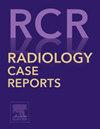新生儿IV级裂孔疝:先天性膈疝的影像学模拟
Q4 Medicine
引用次数: 0
摘要
先天性裂孔疝是一种罕见的新生儿疾病,通常表现为呼吸窘迫,并模仿其他胸部或膈异常,如先天性膈疝。在本报告中,一名8天大的女性新生儿最初根据影像学检查怀疑患有先天性膈疝,但最终被诊断为IV级先天性膈疝。手术探查显示明显的腹部器官疝入胸腔,无膈缺损,证实诊断。多种诊断方式,包括钡剂吞咽x线摄影和计算机断层扫描,是识别病情的关键,强调它们在区分裂孔疝与其他纵隔病理方面的作用。综合手术治疗,包括减少疝内容物和尼森底扩张,有效地解决了疝及其并发症。该病例说明了与裂孔疝相关的临床表现和诊断挑战的可变性,突出了定制诊断和治疗方法的重要性。本文章由计算机程序翻译,如有差异,请以英文原文为准。
Grade IV hiatal hernia in a neonate: A radiologic mimic of congenital diaphragmatic hernia
Congenital hiatal hernia is a rare condition in neonates, often presenting with respiratory distress and mimicking other thoracic or diaphragmatic anomalies such as congenital diaphragmatic hernia. In this report, an 8-day-old female neonate was initially suspected of having congenital diaphragmatic hernia based on imaging studies but was ultimately diagnosed with a Grade IV congenital hiatal hernia. Surgical exploration revealed significant herniation of abdominal organs into the thoracic cavity without diaphragmatic defects, confirming the diagnosis. Multiple diagnostic modalities, including barium swallow radiography and computed tomography, were pivotal in identifying the condition, emphasizing their utility in distinguishing hiatal hernias from other mediastinal pathologies. Comprehensive surgical management, including reduction of herniated contents and Nissen fundoplication, effectively addressed the hernia and its complications. The case illustrates the variability in clinical presentation and diagnostic challenges associated with hiatal hernias, highlighting the importance of tailored approaches for diagnosis and treatment.
求助全文
通过发布文献求助,成功后即可免费获取论文全文。
去求助
来源期刊

Radiology Case Reports
Medicine-Radiology, Nuclear Medicine and Imaging
CiteScore
1.10
自引率
0.00%
发文量
1074
审稿时长
30 days
期刊介绍:
The content of this journal is exclusively case reports that feature diagnostic imaging. Categories in which case reports can be placed include the musculoskeletal system, spine, central nervous system, head and neck, cardiovascular, chest, gastrointestinal, genitourinary, multisystem, pediatric, emergency, women''s imaging, oncologic, normal variants, medical devices, foreign bodies, interventional radiology, nuclear medicine, molecular imaging, ultrasonography, imaging artifacts, forensic, anthropological, and medical-legal. Articles must be well-documented and include a review of the appropriate literature.
 求助内容:
求助内容: 应助结果提醒方式:
应助结果提醒方式:


